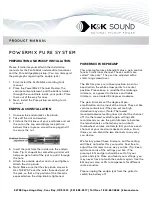
BROADBAND WIRELESS POWER METER
Page 3
The meter should always be inserted into the system in the forward
power direction. Use the arrow labeled “FORWARD SIGNAL” as a
guide when connecting the meter.
Pressing and quickly releasing the ON-OFF button turns the meter
on. The meter will display “Below Range” if it is not connected to a
source that is within it’s dynamic range (0 to 20 dBm).
Once the meter is connected to a source, and a 50
Ω
termination is
placed on it’s output, the forward and reflected power can be meas-
ured. If the meter is not properly terminated the forward power
measurement may be inaccurate.
If the signal applied to the meter exceeds 20 dBm, the meter will read
“Exceed Range”.
VSWR is automatically calculated and displayed according to the for-
ward and reflected measurements. The accuracy of the VSWR meas-
urement depends on several variables (forward and reflected power
levels, attenuation in the transmission line, etc).
Button Description
ON-OFF:
Turns the unit ON or OFF. Unit also powers down five
minutes after last key depression. Powers up to the last
state that it was in.
SELECT:
Depressing the SELECT button cycles through the op
tions available in each mode. The arrow points to the
selected option. Once the desired option has been se
lected depress the mode button until the main screen
returns.
MODE:
First push - Displays remaining battery life.
Second push - Allows selection of the unit of power
(dBm or mW) on the display.
Third push - Allows selection of the frequency band of
interest
Fourth push - Allows selection of the inline attenuator
offset (0, 10, 20, or 30 dB).
Fifth push - Exits MODE and returns to selected moni-
toring state (FWD or REFL.)
Depressing FWD or REFL also exits MODE at any time.
Summary of Contents for t-meter
Page 1: ...Broadband Wireless Power Meter User s Manual ...
Page 9: ...Page 6 P R A X S Y M ...
Page 11: ...Page 8 P R A X S Y M ...
Page 13: ...Page 10 P R A X S Y M ...
Page 18: ...BROADBAND WIRELESS POWER METER Page 15 Notes ...
Page 19: ...Page 16 P R A X S Y M Notes ...






































